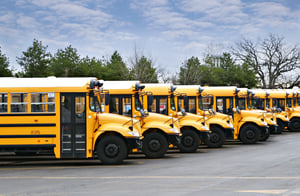California Energy Commission Approves Funding for Over 200 Electric School Buses
published on November 27, 2019 by Sonia Mastros
 Slowly but surely, states and districts across the country are moving away from diesel and towards alternative fuel sources. For years, it seemed like the best choices were either compressed natural gas (CNG) or propane - but these are still forms of fossil fuels, and therefore only a mild improvement over gasoline or diesel. Now, it seems like electric school buses are finally coming to be seen as a possibility.
Slowly but surely, states and districts across the country are moving away from diesel and towards alternative fuel sources. For years, it seemed like the best choices were either compressed natural gas (CNG) or propane - but these are still forms of fossil fuels, and therefore only a mild improvement over gasoline or diesel. Now, it seems like electric school buses are finally coming to be seen as a possibility.
Part of this is advancing technology - it's only in the last few years that electric engines have been seen as powerful enough to be viable on school buses. However, states are also increasingly throwing their weight around. Most recently, California announced that they will be spending around $70 million dollars to purchase more than 200 electric school buses for use across the state.
California Goes Big on Electric School Buses
The buses chosen by the state will be provided by the Canadian-based Lion Electric Company, which specializes in larger electric vehicles, with an average cost of around $300,000 per bus. Some buses will also be provided by Blue Bird, another well-known electric vehicle specialist.
One notable aspect of this is that the majority of the buses will be provided to low-income districts. Too often, only the rich districts are able to afford clean-burning vehicles, which puts even more of a burden on low-income areas. In California, however, bus riders are disproportionately low-income, or in rural areas. So providing clean buses to these areas will be a significant boon to the riders.
It is well known that diesel buses contribute substantially to air pollution, and can have a negative effect on riders. However, recent research has suggested that the damage goes even further, with a study specifically suggesting that exposure to pollution harms educational achievement as well. While research in this area is ongoing, if true, it presents an even stronger reason for states and districts to do whatever it takes to reduce the number of gas-burning buses on the roads.
Plus, beyond all the many health benefits of electric buses, they are also cheaper to maintain. Estimates are that each bus will save its district over $100,000 in fuel and repair work, over the course of the next 20 years.
In short, the California situation is an excellent example of how a state can encourage adoption of green school buses and should, hopefully, be imitated by states around the country.
What do you think? Is it time for states to get serious about funding bus upgrades for districts that could never afford them? Let us know in the comments below!



